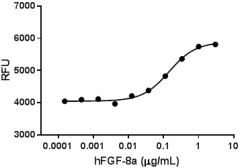- Regulatory Status
- RUO
- Other Names
- Fibroblast growth factor 8, FGF8, Androgen-induced growth factor, AIGF, Heparin-binding growth factor 8, HBGF-8

-

Recombinant human FGF-8a induces proliferation of BALB/c 3T3 cell in a dose dependent manner with ED50 of 0.1 - 0.4 µg/mL. The Deep Blue Cell Viability™ Kit (Cat. No. 424702) was used measure the number of cells. -
Stability testing for human FGF-8a. Human FGF8-8a was aliquoted in 20 mM Tris, 150 mM Na2SO4, 1 mM EDTA, pH 8, 10% glycerol at 0.2 mg/ml. One aliquot was freeze and thawed four times (4x freeze/thaws), and compared to a control kept at 4°C (control). The samples were tested in BALB/c 3T3 cell proliferation assay.
| Cat # | Size | Price | Quantity Check Availability | ||
|---|---|---|---|---|---|
| 773502 | 10 µg | $147.00 | |||
| 773504 | 25 µg | $206.00 | |||
| 773506 | 100 µg | $844.00 | |||
| 773508 | 500 µg | $2636.00 | |||
Select size of product is eligible for a 40% discount! Promotion valid until December 31, 2024. Exclusions apply. To view full promotion terms and conditions or to contact your local BioLegend representative to receive a quote, visit our webpage.
FGF-8 belongs to the fibroblast growth factor (FGF) family and plays an important role in cell growth, embryogenesis, and tumorigenesis. Four isoforms of FGF-8 in human (a, b, e, f) and eight isoforms in mouse (a-h) generated by alternative splicing of the mRNA have been described. Comparing human and mouse, FGF-8a and FGF-8b show identical sequence homology. FGF-8b is predominant form and co-expressed with FGF-8a. The isoforms have different biological functions during embryogenesis. During prenatal stages, FGF-8 is required for the normal development of various organs, including limbs and central nervous system. Misexpression of FGF-8a and 8b proteins results in dysregulation of fate determination in developing brain. In addition, FGF-8 was first cloned from SC-3 mouse mammary carcinoma cells and was found to be induced in response to androgenic stimuli. The isoform FGF-8b has the highest affinity to FGF receptors, elucidating the stronger transforming capacity than FGF-8a. FGF-8b is detected in human prostate and breast carcinoma specimens and cell lines. FGF-8f is associated with the prognosis of esophageal carcinomas. FGF-8e mutation is associated with deficiency of gonadotropin-releasing hormone (GnRH).
Product Details
- Source
- Human FGF-8a, amino acids Gln23 - Arg204 (Accession #: NP_149355), with an N-terminal Met, was expressed in E. coli.
- Molecular Mass
- The 183 amino acid recombinant protein has a predicted molecular mass of approximately 21.3 kD. The DTT-reduced and non-reduced protein migrates at approximately 22 kD respectively by SDS-PAGE. The predicted N-terminal amino acid is Met.
- Formulation
- 0.22 µm filtered protein solution is in 20 mM Tris, 150 mM Na2SO4, 1 mM EDTA, pH 8, 10% glycerol.
- Endotoxin Level
- Less than 0.1 EU per μg protein as determined by the LAL method.
- Preparation
- > 98%, as determined by Coomassie stained SDS-PAGE.
- Concentration
- 10 and 25 µg sizes are bottled at 200 µg/mL. 100 µg size and larger sizes are lot-specific and bottled at the concentration indicated on the vial. To obtain lot-specific concentration and expiration, please enter the lot number in our Certificate of Analysis online tool.
- Storage & Handling
- Unopened vial can be stored between 2°C and 8°C for up to 2 weeks, at -20°C for up to six months, or at -70°C or colder until the expiration date. For maximum results, quick spin vial prior to opening. The protein can be aliquoted and stored at -20°C or colder. Stock solutions can also be prepared at 50 - 100 µg/mL in appropriate sterile buffer, carrier protein such as 0.2 - 1% BSA or HSA can be added when preparing the stock solution. Aliquots can be stored between 2°C and 8°C for up to one week and stored at -20°C or colder for up to 3 months. Avoid repeated freeze/thaw cycles.
- Activity
- The ED50 is 0.1 - 0.4 µg/mL, as determined by a dose-dependent stimulation of BALB/c 3T3 cell proliferation in the presence of 10 µg/mL heparin.
- Application
-
Bioassay
- Application Notes
-
BioLegend carrier-free recombinant proteins provided in liquid format are shipped on blue-ice. Our comparison testing data indicates that when handled and stored as recommended, the liquid format has equal or better stability and shelf-life compared to commercially available lyophilized proteins after reconstitution. Our liquid proteins are verified in-house to maintain activity after shipping on blue ice and are backed by our 100% satisfaction guarantee. If you have any concerns, contact us at tech@biolegend.com.
-
Application References
(PubMed link indicates BioLegend citation) -
- Falardeau J, et al. 2008. J. Clin. Invest. 118:2822.
- Turner N, Grose R. 2010. Nat. Rev. Cancer. 10:116.
- Tanaka S, et al. 2001. Dig. Dis. Sci. 46:1016.
- Payson RA, et al. 1996. Oncogene. 13:47.
- Gemel J, et al. 1996. Genomics. 35:253.
- Han MJ, et al. 2001. Dev Dyn. 220:40.
- Sunmonu NA, et al. 2011. J. Cell. Physiol. 226:1722.
Antigen Details
- Structure
- Growth factor
- Distribution
-
Secreted protein; widely expressed during embryonic stages, such as the primitive streak, limb bud and midbrain-hindbrain junction; low expression levels in adult hematopoietic cells and gonads.
- Function
- FGF-8 is involved in the regulation of cell proliferation and cell differentiation during embryonic development.
- Ligand/Receptor
- FGFR1, FGFR2, FGFR3 and FGFR4.
- Bioactivity
- Measured by its ability to induce proliferation of BALB/c 3T3 cells.
- Cell Targets
- Embryonic progenitor cells.
- Cell Type
- Embryonic Stem Cells
- Biology Area
- Stem Cells
- Gene ID
- 2253 View all products for this Gene ID
- UniProt
- View information about FGF-8a on UniProt.org

